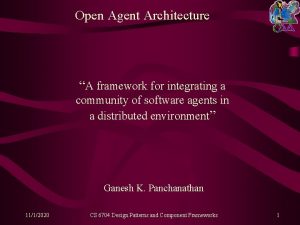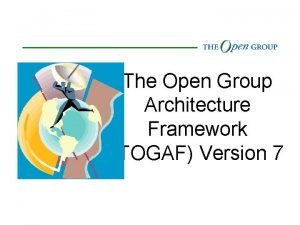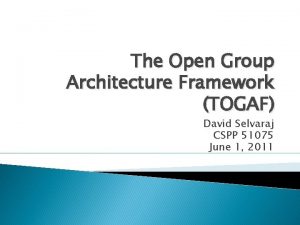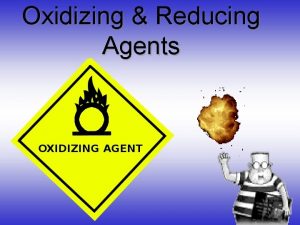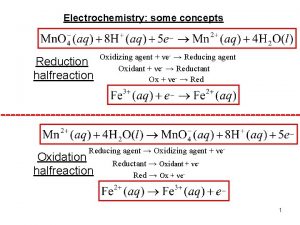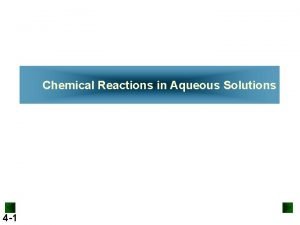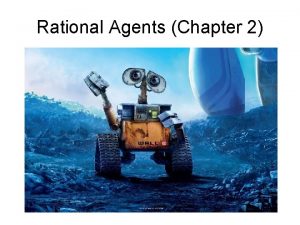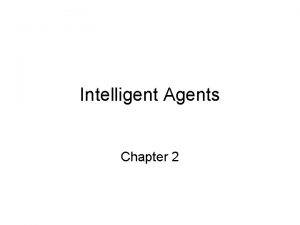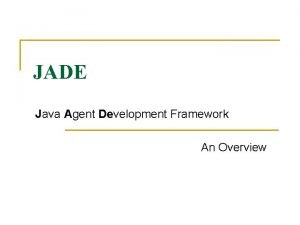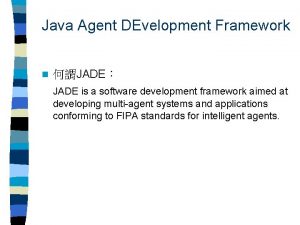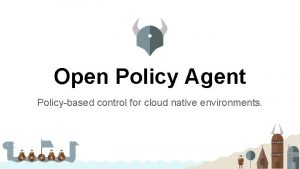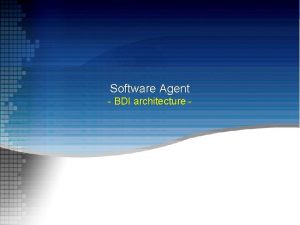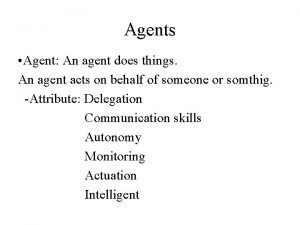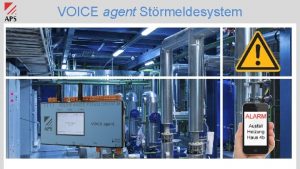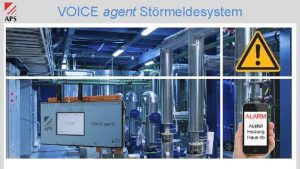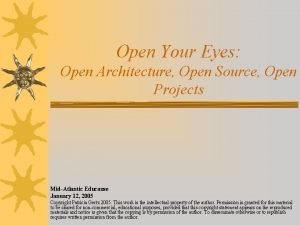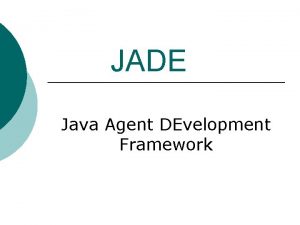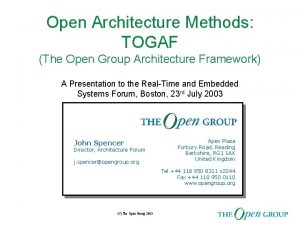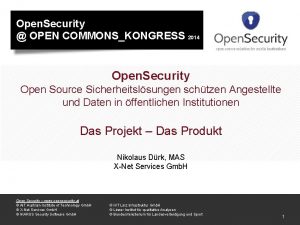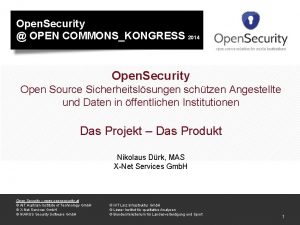Open Agent Architecture A framework for integrating a











- Slides: 11

Open Agent Architecture “A framework for integrating a community of software agents in a distributed environment” Ganesh K. Panchanathan 11/1/2020 CS 6704 Design Patterns and Component Frameworks 1

Overview of the Presentation Part I - Ganesh Comparison with distributed technologies and conversational agents The Delegation based computing model of OAA System structure Example showing Interactions between agents Part II - Murali ICL - Inter-Agent Communication Language OAA Triggers Example OAA Application Scalability and Characteristics of OAA 11/1/2020 CS 6704 Design Patterns and Component Frameworks 2

Distributed Computing methodologies Distributed Objects – CORBA, DCOM + Location Transparency - Explicitly coded interactions - RPC style blocking scheme Mobile Agents – Aglets, Voyager + Network Bandwidth + Parallelism - Must specify where to go and what to do - Little support for interactions among agents - Written in language supported by execution environment Blackboard architecture – FLip. Side, LINDA Data Store + Global Data store - Cannot refer to specific process during computation 11/1/2020 CS 6704 Design Patterns and Component Frameworks 3

Conversational Agents Components for effective communication: § § Transport mechanism Interaction protocol Content language Ontology KQML and KIF § § Knowledge Query and Manipulation Language – Interaction Protocol Knowledge Interchange Format – Content Language Limited by reliance on fixed set of atomic performatives Difficulty in arriving at the right set Belief desire and Intention (BDI) § Stronger assumption about the knowledge and processing of agents § Applicability limited by structural requirements imposed on individual agents. § Difficulties in interoperating with legacy systems. 11/1/2020 CS 6704 Design Patterns and Component Frameworks 4

The Delegated Computing model of OAA Similar to above models, in …… § Creation of networked applications like Distributed Objects § Rich and complex interactions like Conversational Agents § dynamic, flexible, and extensible communities like Blackboard, Publish & Subscribe Requests specify ‘what to be done’ not ‘who to do’ or ‘how to do’ Requests delegated to a specialized server agent – FACILITATOR. Coordinates the activities of agents for the purpose of achieving higher-level, often complex problem-solving objectives. In addition to delegation…… § Direct calls to specific agents like distributed objects § Broadcast requests like Blackboard, Publish and Subscribe 11/1/2020 CS 6704 Design Patterns and Component Frameworks 5

Facilitator Agent Facilitator makes use of knowledge in following locations: § REQUESTER which specifies goal and advices how it should be met § PROVIDERS who register capabilities to the facilitator § FACILITATOR which maintains list of provider agents and strategies § META-AGENTS which contain domain or goal specific knowledge Facilitator coordinates with agents to achieve high level problem solving § § MATCHES a request with registered agent(s) DELEGATES the task to the agent(s) COORDINATES the efforts and communication between agents DELIVERS result to the requester 11/1/2020 CS 6704 Design Patterns and Component Frameworks 6

Goals of OAA Interoperation and coordination § § flexibility in assembling communities of autonomous service providers flexibility in structuring cooperative interactions Impose the right amount of structure on individual agents – KQML Vs BDI Include legacy and “owned-elsewhere” applications. Human oriented user interfaces § § More accessible and intuitive user interfaces for non-expert users Speech recognition and pen-based handwriting/gesture recognition Presentation of Systems’ responses using multiple media Collaboration between users and agents Realistic software engineering requirements § Minimize effort to create new agents and Encourage reuse § Support lightweight, mobile platforms § Minimize language and platform barriers 11/1/2020 CS 6704 Design Patterns and Component Frameworks 7

OAA System Structure Facilitator Agents receive ICL requests and coordinate multiagent execution Natural Language Agents produce requests in ICL User Interface Agents accept multimodal i/p and present results Application Agents wrap legacy applications Meta Agents apply domain knowledge to help other agents 11/1/2020 CS 6704 Design Patterns and Component Frameworks 8

Sample Interaction – Automated Office System What is my Schedule? Facilitator 1 8 2 5 3 UI NL 4 11/1/2020 CS 6704 Design Patterns and Component Frameworks 6 7 Cal 9

Another Sample Interaction When mail arrives for me about security, notify me immediately Facilitator 2 3 1 UI NL 4 5 Mail 6 9 7 Notif Cal 8 4. Installing trigger 10 Tel 5. Signal for mail 7. Meta-Agent in action Key Ideas: § § § Dynamic addition of new agents. Distributed interpretation and execution of a task. Single request produces communication across platform and languages 11/1/2020 CS 6704 Design Patterns and Component Frameworks 10

References • Technical White paper of Open Agent Architecture http: //www. ai. sri. com/~oaa/whitepaper. html • D. L. Martin, A. J. Cheyer, and D. B. Moran, "The Open Agent Architecture: A framework for building distributed software systems, " Applied Artificial Intelligence: An International Journal. Volume 13, Number 1 -2, January-March 1999. pp 91 -128. QUESTIONS? ? ? 11/1/2020 CS 6704 Design Patterns and Component Frameworks 11
 Open agent architecture
Open agent architecture Togaf resource base
Togaf resource base The open group architecture framework
The open group architecture framework Open innovation open science open to the world
Open innovation open science open to the world Oxidizing agent example
Oxidizing agent example Reducing agent and oxidizing agent
Reducing agent and oxidizing agent Redox reaction in alkaline medium
Redox reaction in alkaline medium Agent function vs agent program
Agent function vs agent program Part picking robot peas
Part picking robot peas Java agent development framework tutorial
Java agent development framework tutorial Java agent development framework
Java agent development framework Open policy agent playground
Open policy agent playground
